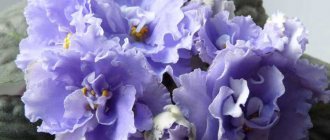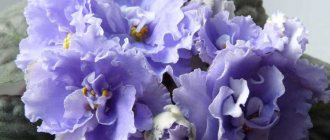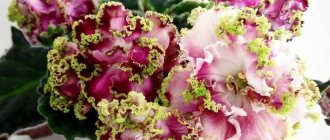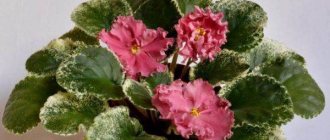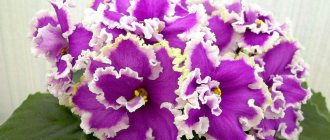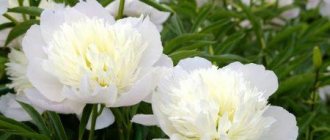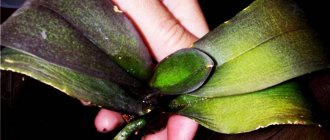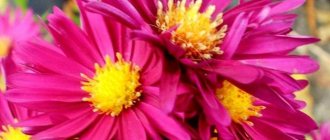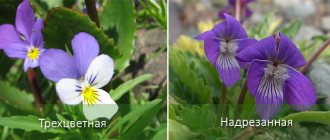Field violet belongs to the genus Violet , family - Violaceae. The species is a cross between several varieties, and under natural growing conditions it reproduces independently – by seeds.
The relevance of the topic of the article is
how to grow a wildflower at home, what kind of soil should be chosen for it, as well as the features and subtleties of caring for a wildflower in open ground and in confined spaces. The article presents pictures of field violets.
What type of forest violets are they?
Forest viola is an excellent plant used for landscape design.
Wild violet is a plant belonging to the Violet family. Most often, forest wild violet can be found in the north, in harsh climates and low temperatures. Today there are more than 100 species of flower. A perennial plant consists of shoots no more than 15 cm in height and 5 petals that form on peduncles. Depending on the type of flower, it can be in different colors:
- purple;
- yellow;
- blue;
- white.
A variety of combined shades are also possible.
Briefly about the history of appearance
Forest violets originated in East Asia. It was from here that their spread to other regions began. They have been actively propagated in horticulture since 1893.
Breeders have bred many species. The most popular of them are “Pansies”, which can be found in different colors and sizes.
The most common type is “Pansy”
How are they different from indoor
The field violet is in no way related to the house flowers that are usually seen on windowsills. They belong to different families and require different conditions for their growth. But they are similar in appearance.
Important ! Homemade Saintpaulia does not tolerate water on the leaves or sunlight. This is detrimental to the plant. In contrast, forest violets are very unpretentious to conditions.
Morphological description
| Botanical illustration from a book Dictionaire des plantes suisses , 1853 | ||||||||||
An annual[2][3] or biennial[4] (perennial)[5] plant with a thin brownish root.
The stems are aboveground, branched, erect or erect, 5-20 (35) cm high.
The leaves are alternate, simple, crenate or crenate-serrate. The lower ones are petiolate, round-oval, the upper ones are almost sessile (at the top of the stem), oblong-lanceolate. The stipules are large, pinnately divided, lyre-shaped with a lanceolate upper lobe.
Flowers are solitary, irregular, zygomorphic (with one axis of symmetry) 6-10 mm in diameter. The perianth is double, there are 5 sepals and petals, not fused together. There are 5 stamens, 1 pistil with a curved style, superior ovary.
The corolla is separate-petalled, funnel-shaped, light yellow, with almost white upper petals. The petals are shorter than the sepals or barely exceed them. The lower petal is almost rounded, has a short spur, not exceeding the length of the appendages of the sepals, in which nectar secreted by the two lower stamens is collected. The upper petals are lanceolate, the lateral petals are directed upward.
Blooms from late spring to autumn; the seeds ripen starting in June.
Cleistogamous flowers often develop, having the appearance of unopening buds, self-pollinating inside.
The fruit is a tricuspid capsule 6-10 mm long. The seeds are obovate, smooth, yellowish-brown.
The diploid set of chromosomes is 34[6].
Common varieties, names
Violet Ek - description, varieties and characteristics of varieties
In the natural conditions of Russia you can find the following types of violets:
- “Pansy” or tricolor - this variety lives as a weed in the forest or fields. Flowering time begins in May and ends in September. The upper petals are blue and the lower petals are white.
- Swamp - blooms from May to August on moss-covered hummocks in the forest, swamps, and water meadows. The flowers are pale blue with dark veins.
- Viola arvensis or field white violet - blooms from April to September on open forest edges and roadsides.
- Dog - blooms in May, small blue flowers, grow in the field and on the edge of the forest.
- Altai - blooms twice a year, the first time from April to May, the second time from September to October. The plants are purple and blue with a yellow center, found on mountain slopes.
Important! Many species of meadow violet have become rare today and are included in the Red Book.
Viola Altai is characterized by the longest flowering
Features of this type
The growth of wild violets has one peculiarity. In nature, it tries to occupy as much area as possible. The same thing happens in the flowerbed.
Forest violet will actively grow, so shoots need to be pinched regularly to control the spread of the plant. When creating a beautiful landscape on your site, you can create a whole field of violets. They are used to form alpine slides.
If the forest viola is planted in the shade, its inflorescences will be pale, but this will extend the flowering time. Elevated areas are best suited for meadow violets so that moisture does not accumulate at the roots.
Good to know…
- Pansies are the official flower symbol of Ingria.
- With its shape, the violet flower is similar to a human figure and symbolizes thoughts. In the language of flowers, the viola flower means: “All my thoughts are about you!” “Folk etymology” is influential here: in French, pensée means both “pansy” and “thought.”
- In England there is a belief that if you pick a pansy on a clear day, it will soon rain.
- In Rus' it was believed that pansies were not suitable for the garden, since they were flowers not for the living, but for the dead.
Recommendations for planting and caring for wild violets
Forest violas take root well in garden plots. But in order for them to grow well, you need to choose the right place for planting.
What kind of soil does he like, light, degree of moisture?
Violet Le - description, varieties and characteristics of varieties
The quality of soil needed for violets may vary depending on the type of plant. There are varieties that need slightly acidic soil, and some thrive only in loose soil.
Important ! In order for the plant to immediately take root on the site, it is recommended to collect the soil in which the violet grew under natural conditions.
Planting in open ground
One of the easiest ways to grow a wild flower is to separate the rosettes from the flowers and plant them in natural conditions. Active flowering begins the next season.
Features of planting seedlings
Violet can be propagated both by sowing and seedlings. The finished bushes are planted at a distance of 20 cm from each other. The soil should contain leaves, sand, peat and humus.
Planting forest viola on a personal plot
Features of planting seeds
To propagate meadow violets with seeds, you need to scatter them on top of the ground, water them and cover them with film.
Important ! Wild violet seeds are very small, which means they can dry out quickly. Therefore, they need to be sown immediately after harvest.
Unpretentiousness
In order for the plant to germinate well and become viable, regular watering and ventilation are necessary. Once the sprout is established, special care is no longer required.
Violet tolerates winter well and does not require additional shelter. It is not afraid of the sun, but it needs to be watered more often.
Medicinal fees
The herb is included in expectorant preparations for respiratory diseases.
- coltsfoot leaves - 20 g,
- large plantain leaves - 30 g
- licorice naked root – 30 g
- violet herb – 20 g
Two tables. Pour a glass of cold boiled water over spoons of the mixture, simmer over low heat for 15 minutes, and strain after cooling. Take the decoction warm, 1/3 cup 3 times a day after meals for bronchitis.
- 2. Violet herb - 1 part
- sundew grass - 1
- plantain leaves — 1
- fennel fruits - 1
One tbsp. Pour a spoonful of the mixture into a glass of boiling water and leave for 30 minutes. Take 1/4 cup 3 - 4 times a day for convulsive cough, whooping cough.
- 3.Primrose flowers - 1 part
- sundew grass - 1
- licorice root - 1
- violet root - 2
- cumin fruits - 2
One table. Pour a spoonful of the mixture into a glass of boiling water, leave for half an hour, strain. Take 1/4 - 1/3 cup 3 - 4 times a day after meals for cough, whooping cough, bronchitis, bronchial asthma.
The plant is also included in preparations for the treatment of the urinary tract.
- Juniper fruits - 1 part
- violet herb - 1
- lovage root - 1
- flax seed - 1
Pour one tablespoon of the mixture into a glass of boiling water, boil for 10 minutes, leave for an hour. Take 1/3 - 1/2 cup 3 - 4 times a day for bladder inflammation.
For psoriasis, use herbal infusion:
- tricolor violets - 10 g
- celandine - 10 g
One tbsp. Pour 200 ml of boiling water over a spoonful of the mixture and cover with a lid. Leave for 1.5 hours, strain. Take 2 - 3 tbsp. spoons of infusion 3 - 5 times a day before meals.
In Rus', tricolor violet was used for dental problems. When teeth were loose, they drank an infusion: 1 tbsp. spoon of dry herb or 1.5 tbsp. spoons of crushed fresh into 2 cups of boiling water or taken in the form of herbal powder 0.6 - 4 g with sugar 2 times a day.
Contraindications
- Gastritis and peptic ulcer of the stomach and duodenum during exacerbation.
- Herbal preparations are contraindicated for hepatitis and glomerulonephritis.
- Pregnancy, lactation - breastfeeding.
- Children's age up to 12 years.
- Individual intolerance.
The drugs should not be used for a long time; the plant contains alkaloids. It is recommended to take the course for no more than a month, then there should be a 1-month break.
Pest prevention
Violet Blue Mist - description and characteristics of the variety
Preventative measures against parasite attacks include compliance with all necessary growing conditions. It is necessary to regularly inspect leaves and flowers.
If the plant is attacked by nematodes or clover cutworms, then treatment should be carried out already at the initial stage of infection. At this point, you can still use traditional methods. If there are a lot of insects, you can only get rid of them with the help of chemicals.
Can it be planted indoors?
The white forest violet, like other types of wild flowers, is very difficult to tolerate indoor conditions. They need a wide area to grow. In a small pot, the root system will rot. This will lead to death.
Pansy flowers
Garden pansies originated from crossing the tricolor violet with other species - mainly Altai and yellow. Over time, countless ornamental varieties have appeared.
Violets were Goethe's favorite flowers. In honor of the poet, German gardeners developed large-flowered varieties, naming them after the characters in his works: the almost black variety was called Doctor Faust, the bright red variety was called Mephistopheles, and the pale blue variety was called Margarita. In the south of France and Northern Italy, near Parma, the Parma violet is grown - a large-flowered, terry variety of fragrant, it is used for the production of perfume.
Watch the video, there are a lot of useful tips.
When and how does it bloom
Flowering time and plant shape depend on the species and conditions in which the plant is located.
During flowering, the main species of wild violets have flowers of five petals, two of which are located at the top and three at the bottom.
You can find varieties that look similar to cyclamen. These include the rare notched one.
Some species, for example, dog and fragrant viola, can bloom continuously all summer. On average, wild violets bloom from May to September.
During flowering, the plant does not require intensive care. It is enough to carry out standard watering.
It is important to regularly inspect the plant for pests.
Literature
- Gubanov, I. A. et al.
[herba.msu.ru/shipunov/school/books/gubanov2003_illustr_opred_rast_sred_rossii_2.djvu Illustrated guide to plants of Central Russia. In 3 t]. — M.: Scientific T. ed. KMK, Institute of Technology. research, 2003. - T. 2. Angiosperms (dicotyledonous: separate-petalled). - P. 565. - ISBN 9-87317-128-9. - Illustrated guide to plants of the Leningrad region / Ed. A. L. Budantseva and G. P. Yakovleva. — M.: Scientific T. ed. KMK, 2006. - P. 189. - ISBN 5-87317-260-9.
- Nikitin V.V.
Violets (Viola L., Violaceae) of the Altai Territory // News of the taxonomy of higher plants. - M.-St. Petersburg: Scientific T. ed. KMK, 2006. - T. 38. - P. 165-201.
Use of field violets in folk medicine
Wild viola is popular not only for its beautiful appearance, but also for its beneficial composition. It contains vitamins C and A, essential oils. The plant is actively used in folk medicine. It is used for:
- gargling;
- temperature reduction;
- as an expectorant, diuretic and analgesic.
The forest plant has also found its use in cosmetology. It is used to smooth out wrinkles and heal cracks.
Important! You need to be very careful when using wild violet for treatment, as it contains alkaloids and toxic substances.
Forest viola is an excellent plant for decorating a site and designing alpine slides. Proper use will help to use it not only for decorative, but also for medicinal purposes.
Notes
- For the convention of indicating the class of dicotyledons as a superior taxon for the group of plants described in this article, see the section “APG Systems” of the article “Dicotyledons”.
- Mayevsky P.F.
Flora of the central zone of the European part of Russia. — 10th ed. — M.: T-vo scientific publications KMK. - 2006. - P. 371. - ISBN 5-87317-321-5 - Illustrated guide to plants of the Leningrad region / Ed. A. L. Budantseva and G. P. Yakovleva. — M.: T-vo scientific publications KMK. - 2006. - P. 199. - ISBN 5-87317-260-9
- ↑ 1 2 I. A. Gubanov et al.
Illustrated guide to plants in central Russia. - T. 2. - M.: T-vo scientific publications KMK. - 2003. - P. 565. - ISBN 5-87317-128-9 - Gorchakovsky L.P. et al.
Key to vascular plants of the Middle Urals. — M.: Science. - 1994. - P. 316. - ISBN 5-02-004167-X - ↑ 1234
Nikitin V.V., 2006, p. 165-201. - Illustrated guide to plants of central Russia, vol. 2 / I. A. Gubanov, K. V. Kiseleva, etc. - M.: KMK Publishing House, 2003. - 565. ISBN 5-87317-128-9
- Atlas of habitats and resources of medicinal plants of the USSR. - M. - 1983. - P. 319.
- Illustrated guide to plants of the Leningrad region / Ed. A. L. Budantseva and G. P. Yakovleva. — M.: Scientific T. ed. KMK, 2006. - P. 199. - ISBN 5-87317-260-9.
- ↑ 1 2 Blinova K. F. et al.
[herba.msu.ru/shipunov/school/books/botaniko-farmakognost_slovar1990.djvu Botanical and pharmacognostic dictionary: Reference. allowance] / Ed. K. F. Blinova, G. P. Yakovleva. - M.: Higher. school, 1990. - P. 251. - ISBN 5-06-000085-0.
